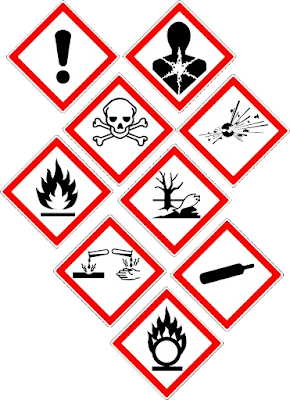“Test Your Knowledge: The Ultimate GHS Pictogram Quiz!”
Basically, these nine (9) pictograms are used in the Globally Harmonized System of Classification & Labeling of Chemicals (GHS) to indicate a chemical’s distinct risks. Each pictogram is made to be instantly identifiable & to provide crucial details about the risks posed by a certain substance.
The following is a description of each pictogram:
Flame: Using this symbol, you can represent a flammable chemical. It has a stylised flame in the middle of a red diamond or square shape. The usage of the flame sign indicates that the chemical is quickly ignited & burnable. In short, Flammable materials or substances capable of igniting when exposed to water or air (pyrophoric), or emitting flammable gases.

Exclamation Mark: This symbol is used to denote a material that might be harmful to human health. It has a stylised exclamation mark in the middle of a red square. The exclamation point symbol is used to indicate that the substance may be harmful when in contact with the skin when inhaled or consumed. Simply it might cause immediate respiratory, skin, or eye irritation, narcotic.
Corrosion Hazards: A material that corrodes metals is denoted by this pictogram. It has a stylised corrosive sign in the centre of a red square. The word “corrosive” indicates that a material can seriously harm the skin, eyes, or respiratory system, as well as corrode metallic materials. In short, This pictogram indicates materials that cause corrosion or skin burns or eye injury on contact, or that are corrosive to metals.
Skull & Cross-Bones Hazards: Using this symbol, you may identify a chemical that is bad for your health. It is shaped like a red diamond or square with a stylised skull & crossbones in the middle. The skull & crossbones sign is used to indicate that a material is extremely poisonous & can have a negative impact on human health if it is not handled appropriately. In short, Such substances have quick & severe harmful effects, such as poisons & highly concentrated acids (acute toxicity).
Aquatic Environmental Hazards: A material that is hazardous to the environment is denoted by this above-shown symbol. It has a stylized fish and plant image in the centre of a red square or diamond shape. The fish & plant sign is intended to convey that the material can be harmful to the environment and aquatic life. In short, they are harmful substances for sea creatures.
Exploding Bomb Hazards: Using this symbol, you can represent an explosive chemical. It has a stylised image of an exploding bomb in the middle of a red square/diamond. The explosive bomb symbol is used to indicate that a substance is very flammable & capable of igniting into an explosion. In short, we can say that explosives could detonate even when not exposed to air, such as organic peroxides and extremely unstable substances (self-reactive).
Gas Cylinder Hazards: Use this symbol to represent a compressed gas. It is a red diamond or square with a stylized gas cylinder sign in the middle. The sign for a gas cylinder indicates that a material is under pressure storage or simply it contains compressed gas which could be hazardous if released. In short, This symbol indicates that there are compressed gases, such as ammonia or liquid nitrogen.
Carcinogenic Hazards: A carcinogen or substance with respiratory, reproductive or organic toxicity which causes damage over time (chronic or long-term health risk). A chemical, or agent that can cause cancer is referred to as a carcinogen.
Flame Over Circle Hazards: This symbol determines the oxidizers. Oxidizers are substances that speed up burning or increase the heat and duration of fires.
In Conclusion:
The GHS’s nine pictograms are intended to convey a chemical’s specific dangers in an understandable & identifiable manner. To handle & work with hazardous substances properly, both employers & employees must be aware of these pictograms & recognize what each symbol means.
“Test of GHS – Pictograms”!
To warn users of the potential chemical risks they may be exposed to, OSHA’s Hazard Communication Standard (HCS) mandates the use of pictograms. The Globally Harmonized System of Classification & Labeling of Chemicals standards is represented by the pictogram. Luckily, it’s called GHS & features a symbol on a white backdrop with a red border that designates a specific hazard (s).
Employers are obligated to provide workers with training on Chemical Safety Data Sheets & the hazards highlighted in each pictogram as part of OSHA’s Hazard Communication Standard programme.
Which GHS pictograms are you most familiar with?
Let’s find out!








